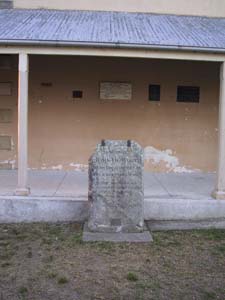The Stephens and King families, two well-known surnames in the Ebenezer/Sackville district, share a plot at the Anglican Cemetery on Tizzana Road, Sackville. The two families were connected by marriage, when Walter King married Elizabeth Stephens in 1874.
 |
The Stephen & King headstones at Sackville Cemetery
Photo: M. Nichols, 2017
|
Walter was born in Glebe in 1849, the son of James Kelsey King, a tailor, and his wife Mary nee Baker. James and Mary with their three daughters, arrived in Sydney in 1838. The couple had an additional six children after arriving, including Walter. The family settled in Sydney and appeared to prosper in their new surrounds.
In the 1860s, a Provisional School consisting of a slab building was established at the junction of the Colo and Hawkesbury. Walter was appointed as a teacher and taught at the Lower Portland School from 1869 until 1872. The teacher was given a boat to row pupils to & fro across the riverways. He was noted as “an upright and a very conscientious teacher.”
A school was also established at Portland Head, but became known as Ebenezer Public School in 1887. King taught at Ebenezer from 1872 and was appointed as the Schoolmaster in the mid-1880s. Classes were originally held in the Ebenezer Church until a new weatherboard building was built on Coromandel Road. This building was destroyed by a bushfire in 1901 and the school was eventually relocated to its present site on Sackville Road with new buildings opening in 1902. King retired in 1912.
John Stephens was born in England in about 1806 and by his mid-20s was recorded as a Mason and Master Builder. He had lived in the Cornwall area for many years and was noted as a builder. John was sentenced to Life in 1833 after being caught forging a bill, and arrived on the ‘Neva’ in 1833. John married Elizabeth Brown in 1843, whilst living in Maitland, and shortly after they moved to Windsor. John and Elizabeth had six children including Elizabeth. They also raised Elizabeth’s niece from birth.
 |
Ebenezer School circa 1904
Photo: State Archives (NSW)
|
John Stephens senior is attributed as building Buttsworth’s Mill at Wilberforce, in the late 1840s. Their sons, James Brown (1849) and John Gross (1850) were also well-known stonemasons and worked alongside their father, eventually taking over the business.
Some of the structures built in Ebenezer and Sackville include Rockleigh ca 1870; Coromandel ca 1890; Girrawa Park (now Pickwick Park); Stonehill; Ebenezer Villa; St Thomas Anglican Church, Sackville completed in 1871; Sackville North School built in 1878, now known as Brewongle Field Study centre. They also built Tizzana Winery in 1887, the Sackville Methodist parsonage and the St Albans Court House which was completed in 1892. These surviving properties, built by remarkable craftsmen, are important examples of sandstone construction, and contain outstanding heritage features.
John Stephens senior died in 1890 aged 84 and is buried at Sackville cemetery, with his wife Elizabeth who passed away twelve months earlier. Son John died in 1922 aged 71 and James died a few months later, aged 73. Both are buried at Sackville Cemetery.
 |
The Stephen home on Tizzana Road Ebenezer
Photo: M. Nichols, 2018
|
Walter and Elizabeth King built their own residence on Sackville Road, called ‘Twyfordville’. Walter was a popular teacher, well-like by the students and the local community. In 1912, after a career spanning over thirty years, he retired from teaching.
 |
| Report of
Walter’s death in Windsor& Richmond Gazette 26 Oct 1934 |
Walter passed away near Gosford, aged 86 years, in 1934 and was buried at Sackville Cemetery. As a mark of respect, the local school children stood and saluted as the cortege passed Ebenezer School. Elizabeth died two years later and their headstone is side by side John and Elizabeth Stephens, in the Anglican Cemetery at Sackville.





